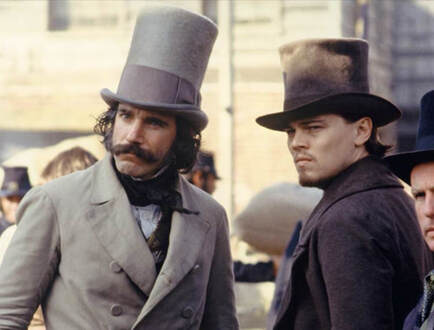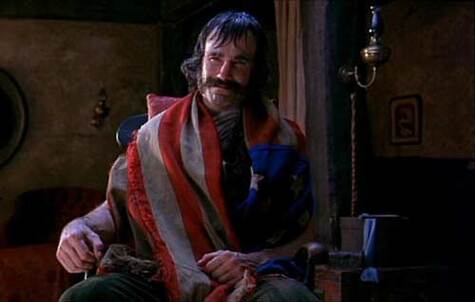A- | Irish immigrants fight to carve out a piece of 1860's New York City. Directed by Martin Scorsese Starring Daniel Day-Lewis, Leonardo DiCaprio, and Cameron Diaz Review by Jon Kissel |

The identity of the country through Gangs of New York is far from the tainted idealism of its founding. Brutal warfare is taking place far away in the South, itself a response to brutality, and there’s lawless clan warfare in its largest city. The state, supposed to have a monopoly on violence, shares that power with what could only be called warlords and their grifter partners in Tammany Hall. More that the naked facts of hierarchy, the romantic promise of the country, of leaving old rivalries and feuds from the Old World across the Atlantic where they belong and coming to a place free from history, is a lie, especially where it concerns the Irish and their English oppressors. The issues and the stakes are different in their New World conflict, but the sides remain the same.
The film’s vision of a unified country isn’t one where the aforementioned promise is fulfilled, but the same one that every country aspires to: order and a monopoly on violence. That’s a primal nugget but this is a primal film. Gangs of New York ends with the state asserting its will over the characters own prerogatives, dismissing them in a hail of gun and cannon fire as insubstantial and subordinate. Something could conceivably thrive in the aftermath, after the next-door exploiters are rubbed out and pacified, but the big exploiters like Jim Broadbent’s Tweed remain, there to take his cut from whatever survives. The only optimism in the film comes from Cameron Diaz’s Jenny Everdeane, with her dreams of the West and the frontier that acts as a release valve for the pressure of the industrialized East. Whatever is borne out of the boiling stew of Manhattan will happen with or without her and DiCaprio’s Amsterdam, and will be endlessly refreshed by a constant stream of new immigrants who themselves believe the promise and will soon discover the lie.
This most recent viewing of Gangs of New York puts it in synch with this interpretation of America through Priest Vallon’s (Liam Neeson) repeated motto, ‘the blood stays on the blade.’ This is easily imagined as something Irish tribes lived and died by as they spent centuries warring against some other tribe for a slight that no one remembers anymore. Whether America’s history-erasing promise gets fulfilled or not, that kind of idea doesn’t translate across the Atlantic. The most famous feud in the country, the Hatfields and McCoys, feels like a tall tale, happening in some desolate holler far away from the actual life of the nation. Keeping one’s heart always turned towards vengeance is no way to run a society. It makes commerce and productivity impossible, to say nothing of more abstract but just as vital concepts like solidarity. The characters that we first see in the prologue fighting alongside Priest have long ago disabused themselves of this idea by the time the film catches up with them in the 1860’s. Day-Lewis’ Bill the Butcher can’t stomach the Irish for a lot of noxious reasons, but this clannish impulse that Priest passes to his son Amsterdam is better than most.

As he is subject to doomed demographics, Bill ultimately has to lose, so the film’s choice to make him as perversely appealing as possible is a wise one. Scorsese is no stranger to repellant protagonists who nonetheless have charisma. DiCaprio will eventually play one of his own for Scorsese. Day-Lewis is iconic in the role, brimming with performative showmanship as a way to keep control and occasionally willing to let his mask drop. The hat, the hair, the eye, and the knives are instantly memorable. He’s got so many great lines, inflected with a vernacular that I choose to believe is accurate. The narration is a weak spot of this film, but Amsterdam’s line about a dragon’s wing being warm is appropriate, if a little corny. A better film would make Amsterdam more conflicted about killing his father’s murderer, or would make a better case for why Bill has to go, albeit before he kills Brendan Gleeson’s Monk which provides all the necessary rationale. The film buys into the revenge narrative a little too much, which is itself a testament to Day-Lewis’ Mephistophelian work.
As powerful as Day-Lewis is, DiCaprio has yet to figure out how to work most effectively with Scorsese. Some of that is on the narration, the most earnest of Scorsese’s career. In something like Goodfellas or Taxi Driver, the narration is Unreliable with a capital U and therefore the only kind of narration that’s acceptable. It’s pure real-time thoughts here, crippling DiCaprio’s work by not asking that much of him. He’s going to soon do the best work of his career for Scorsese several times over, but this is not that. Alongside him is Diaz, who I wouldn’t say is bad but who could be better. She’s best when her Jenny isn’t putting on a con-woman’s act and is letting her real feelings show, specifically when Amsterdam is recovering his medal from her. Some of the unimpressiveness of DiCaprio and Diaz is sharpened by them being alongside not only Day-Lewis, but the film’s deep bench of memorable characters, from Gary Lewis’ McGloin, the dancing Irish bear of Bill’s posse, to the poker player that gets his hand stabbed and his head stroked by Bill. The actor playing the Catholic priest as a long-bearded druid is doing his best work; Diaz and DiCaprio aren’t.
For every dead line or missed opportunity, however, there’s several stunning shots or sequences. Starting with one of my favorite Scorsese tracking shots set to one of my favorite pieces of music in a Scorsese film, Gangs of New York establishes itself as a work of singular ambition. The chaos of the old church mixes well with the chaos of that first street fight, giving itself over to surrealism the moment that Hell-Cat Maggie dives in like an X-Man on an unsuspecting native and the score takes a modern turn. This is the only anachronism in the film’s score, much of which is later given over to Irish hymns and folk songs that speak to the tragedy and resilience of their existence. This is the Scorsese film that most turns itself over to production design and costuming, a grand canvas that he applies as much verve to as anything else he does.
The other standout narration line is ‘the earth turns and we don’t feel it move.’ It’s not enough to absolve the film of its narration problems, but it helps. Amsterdam says this line but he becomes a victim of the same sentiment as the draft riots of the finale overtake him and everyone else’s grand vision of a gang fight to end all gang fights. Instead, the only people that swing their knives are he and Bill, the latter of which is brought low by a piece of shrapnel that could’ve just as easily pierced Amsterdam’s guts. Old ways become obsolete without anyone’s consent, leaving those passed by to adapt or be buried in untended and overgrown graves. Gangs of New York is deep with allegory and subtext about America, but its final statement of individuals being overtaken by events applies everywhere and to everyone. B+
 RSS Feed
RSS Feed